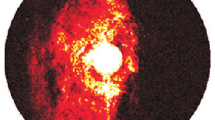Abstract
The noise immunity of radars is essentially reduced under the simultaneous exposure to active noise and passive interferences. This is stipulated by the passive interference decorrelating the active noise and also by the disruption of interperiod correlation of passive interference during the adaptation of weight coefficients of spatial filter. This paper proposes and investigates a new method of forming the classified training sample (CTS) based on the interchannel correlation analysis of range signal. This method makes it possible (in the current sounding period in terms of the maximum magnitude of interchannel correlation coefficient) to determine the range interval, within which the passive interference has the minimum level, and to form the optimal value of weight coefficient of spatial filter for its use in the next sounding period. In addition, the method allows us to form an optimal weight coefficient for compensation of active noise interference in all sounding periods of the next frequency burst during the burst-mode signal processing in the last sounding period of the current burst. The simulation process has revealed that in this case the modulation of passive interference present in compensation channel is also eliminated. It can essentially enhance the efficiency of extraction of useful signals against the background of passive interferences during the time (frequency) processing at the second stage of space-time signal filtering in radars. It has been established that the use of CTS makes it possible to significantly reduce the duration of transient during the adaptation of weight coefficients of spatial filter that enables us to enhance the efficiency of active noise suppression under the simultaneous exposure to nonstationary passive interferences.








Similar content being viewed by others
References
D. I. Lekhovytskiy, V. P. Ryabukha, G. A. Zhuga, D. S. Rachkov, A. V. Semeniaka, “MTD in pulse radars: 5. Adaptive systems for interperiod processing of Gaussian signals against the background of Gaussian clutter,” Applied Radio Electronics 10, No. 4, 508 (2011). URI: http://openarchive.nure.ua/handle/document/4718 .
“Method and radar system for repetition jammer and clutter suppression,” US Patent 9.170.321 (12 Sep. 2013).
V. G. Andrejev, T. P. Nguyen, “Adaptive processing of signals on a background of clutter and noise,” Radioelectron. Commun. Syst. 58, No. 2, 85 (2015). DOI: https://doi.org/10.3103/S0735272715020053 .
V. A. Grigoriev, Combined Processing of the Signals in Radio Communication Systems [in Russian] (Eko-Trends, Moscow, 2002).
B. Widrow and S. D. Stearns, Adaptive Signal Processing (Prentice-Hall, Englewood Cliffs, N.J., 1985).
V. P. Riabukha, D. S. Rachkov, A. V. Semeniaka, Y. A. Katiushyn, “Estimation of spatial weight vector fixation interval for sequential space-time signal processing against the background of combined interferences,” Radioelectron. Commun. Syst. 55, No. 10, 443 (2012). DOI: https://doi.org/10.3103/S0735272712100020 .
S. Khadka, M. S. Anuradha, and C. Padmasree, “Study of the effect of barrage and deception jamming on a radar system along with their mitigation technique,” Int. J. Sci. Res. 4, No. 9, 98 (2015). URI: https://www.ijsr.net/archive/v4i9/SUB1578 82.pdf .
D. M. Piza, S. N. Romanenko, D. S. Semenov, “Correlation method for forming the training sample for adaptation of the spatial filter,” Radio Electronics, Computer Sci., Control, No. 3, 34 (2018). DOI: https://doi.org/10.15588/1607-3274-2018-3-4 .
D. M. Piza, G. V. Moroz, “Methods of forming classified training sample for adaptation of weight coefficient of automatic interference compensator,” Radioelectron. Commun. Syst. 58, No. 1, 32 (2018). DOI: https://doi.org/10.3103/S0735272718010041 .
“Adaptive cancellation arrangement,” UK Patent 1 599 035 (30 Sep. 1981).
D. M. Piza, D. S. Semenov, S. V. Morshchavka, “Efficiency estimation of discrete algorithms for adaptation of weight coefficients in space-time processing of radar signals,” Radioelectron. Commun. Syst. 62, No. 1, 6 (2019). DOI: https://doi.org/10.3103/S0735272719010023 .
R. A. Monzingo, T. W. Miller, Adaptive Arrays (John Wiley & Sons, 1980).
Acknowledgements
This study was carried out within the framework of State-funded research project of Zaporizhzhia National Technical University “Development and improvement of methods for radar signal processing under exposure to combined interferences,” registration # 01170000614 with financial support of the Ministry of Education and Science of Ukraine.
Author information
Authors and Affiliations
Corresponding author
Ethics declarations
ADDITIONAL INFORMATION
D. M. Piza, S. N. Romanenko, and D. S. Semenov
The authors declare that they have no conflict of interest.
The initial version of this paper in Russian is published in the journal “Izvestiya Vysshikh Uchebnykh Zavedenii. Radioelektronika,” ISSN 2307-6011 (Online), ISSN 0021-3470 (Print) on the link http://radio.kpi.ua/article/view/S0021347020050040 with DOI: https://doi.org/10.20535/S0021347020050040
About this article
Cite this article
Piza, D.M., Romanenko, S.N. & Semenov, D.S. Enhancing Efficiency of Space-Time Processing of Radar Signals under Exposure of Combined Interferences. Radioelectron.Commun.Syst. 63, 257–264 (2020). https://doi.org/10.3103/S0735272720050040
Received:
Revised:
Accepted:
Published:
Issue Date:
DOI: https://doi.org/10.3103/S0735272720050040




